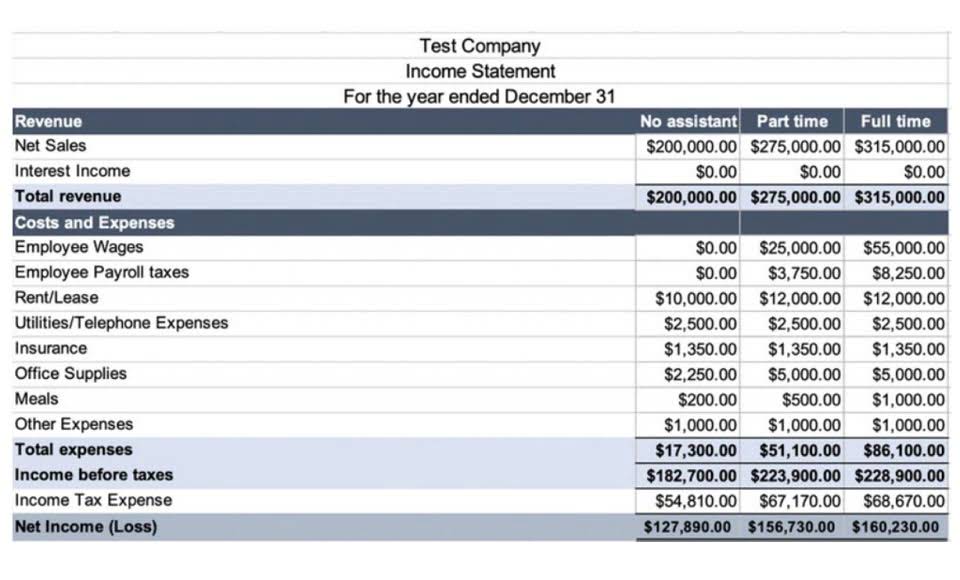Content
- When Should A Company Recognize Revenues On Its Books?
- Congress Should Further Restrict Use Of The Completed Contract Method
- Change Proposed To The Way Ohio Taxes Businesses And Business Owners
- Advantages Of A Completed Contract Method
- How To Prepare For $15 Federal Contractor Minimum Wage Implementation

The CARES Act included the Paycheck Protection Program (“PPP”), which was to provide funding for small businesses to maintain their payroll, hire back employees that were laid off and cover certain overhead costs. The AMT adjustment is fully omitted, which is a glaring red flag on a small contractor tax return, and this carries a heavy potential of accuracy-related penalties. Be the first to know when the JofA publishes breaking news about tax, financial reporting, auditing, or other topics. Select to receive all alerts or just ones for the topic that interest you most. Except that X and PRS properly account for the contract under the CCM, and X has a basis of $610,000 in the contract . Accordingly, X’s basis in the Z stock is reduced by $600,000 to zero and X must recognize income of $50,000. Definition of old taxpayer and new taxpayer for certain partnership transactions.
This is an area where your CPA can really help you if they are involved in the planning process and understand your business objectives. Our strong team of experienced tax, audit, accounting, and advisory professionals are invested in helping you reach your goals. We specialize in serving auto dealerships, construction operations, energy and natural resources, financial institutions, healthcare physicians and practices, and nonprofit and governmental agencies, throughout West Virginia, Ohio, and Kentucky. Because this standard allows companies to recognize revenues and expenses during the construction period. Meanwhile, in both years, the recognition of cash position and construction-in-progress accounts is the same as the US GAAP standard.
When Should A Company Recognize Revenues On Its Books?
Except that X receives progress payments of $800,000 (rather than $650,000) and transfers the contract with a basis of $600,000 and $125,000 of cash to a new corporation, Z, in exchange for all of the stock of Z in a section 351 transaction. In the case of a contract accounted for under the CCM, any built-in income or loss under section 704 is taken into account in the year the contract is completed. Total allocable contract costs for the new taxpayer are the allocable contract costs as defined under paragraph of this section incurred by either the old taxpayer prior to, or the new taxpayer after, the transaction.



A contract is assumed to be complete when the remaining costs and risks are insignificant. Conversely, under the completed contract method, the company would not record any revenue or expenses on its income statement until the end of the project. Assuming that the project was finished on time and the customer paid in full, the company would record revenue of $2 million and the expenses for the project at the end of year two.
Congress Should Further Restrict Use Of The Completed Contract Method
Thus, most contractors can’t use it because merchandise includes any item physically incorporated in a product, including all building materials. The TCJA reduced the impact of the AMT on many taxpayers by repealing it for C-Corporations and increasing the exemption amount for owners of pass-through entities. Nonetheless, AMT requires that all long-term contracts are accounted for under the Percentage-of-Completion method. If a method other than Percentage-of-Completion is elected for income tax purposes, an adjustment will be required for AMT. Taxpayers should make sure to consider any AMT impact as part of any accounting method change with respect to their long-term contract accounting method.
POWELL INDUSTRIES INC Management’s Discussion and Analysis of Financial Condition and Results of Operations (form 10-K) – marketscreener.com
POWELL INDUSTRIES INC Management’s Discussion and Analysis of Financial Condition and Results of Operations (form 10-K).
Posted: Wed, 08 Dec 2021 17:29:04 GMT [source]
These costs will be seen at the end of the contract as in US GAAP or incurred during construction as in IFRS. So, for example, contracts and construction are completed in the same period; for instance, in one year, this method will be the same as the percentage completion method. The contract is completed when all parties agree, and the company sends or submits the results to the contractor. The accrual method – less retainage is similar to the accrual method discussed above, with one exception. Under this method, the retainage receivables and retainage payables are not recognized until received or paid. This could provide benefit to a taxpayer with large retainage receivable balances, as that income is not recognized until the cash is received. Since contractors often work on several contracts simultaneously and because contractors often incur costs that are not specific to a particular contract, these costs must be accumulated and allocated to specific contracts.
Change Proposed To The Way Ohio Taxes Businesses And Business Owners
A key component of utilizing the completed contract method is making sure you are managing your backlog. Note that the $1 million exception would apply to contractors with revenues greater than $300 million over the previous 3 years.
If it is added to the previous year’s cash of minus Rp220 and the cash payment of Rp400, the company’s cash position increases by Rp100 in the second year. Under US GAAP and IFRS, companies can use this method when results cannot be measured reliably. However, both differ in recognizing revenue and expenses related to the contract. You cannot, however, include the cost of supplies or materials you allocated to the contract but never used as an allocable contract expense.
Advantages Of A Completed Contract Method
For a construction contractor that means using the Percentage of Completion Method for their financial statements. On the other hand, most taxpayers want to use an accounting method that provides a tax benefit resulting from a delay in income recognition. The tax law allows more than one permissible overall accounting method for contracts for certain taxpayers, but any tax method is subject to review if the government determines it does not clearly reflect income. Under this method there is an accounts receivable account whereby the customer simply fronts money during the construction process. With the percentage of completion method, the customer is legally obligated to pay as the project goes through stages of construction. With the completed contract method, the contract states that the legal obligation is fulfilled once the project is done. The percentage of completion method is different because it often takes more than a year to complete the work, therefore the contractor wants to recognize his earnings as he progresses.
AO couldn’t change method of accounting consistently followed by assessee to determine income on estimate basis INCOME TAX : where assessee, engaged in construction of flats, was consistently following completed contract method of accounting and said met… https://t.co/8B9rv2lMYJ
— TAXFILES INDIA (@taxfilesind) July 22, 2020
CCM accounting is helpful when there is unpredictability surrounding when the company will be paid by their customer and uncertainty regarding the project’s completion date. The cash basis of accounting recognizes revenues when cash is received, and expenses when completed contract method they are paid. Another popular exception to the required use of the percentage of completion method is the “home construction contract” exception. Unlike the small contractor exception, this provision applies for both regular tax accounting and AMT accounting.
How To Prepare For $15 Federal Contractor Minimum Wage Implementation
Clark Schaefer Hackett will not be held responsible for any claim, loss, damage or inconvenience caused as a result of any information within these pages or any information accessed through this site. The definition of “construction contractor” generally excludes architects, engineers, construction managers and commercial painters. The Cash Method could allow for tax savings if the income is received in a subsequent period for work performed in the current year. But if your business is service-based, you may be able to use the Cash Method for that element of your business, even though PCM would be required for other jobs. Service-centric jobs are generally more short-term in nature than longer-term construction jobs. Small contractors may be able to use the Cash Method, but will still be required to use the PCM for jobs longer than 2 years.
How do you find the degree of completion in contract costing?
The Percentage of completion formula is very simple. First, take an estimated percentage of how close the project is to being completed by taking the cost to date for the project over the total estimated cost. Then multiply the percentage calculated by the total project revenue to compute revenue for the period.
Therefore, contractors are required to analyze the implications of taxes before using the completed contract method. Accounting method refers to the rules a company follows in reporting revenues and expenses in accrual accounting and cash accounting. Accrual accounting is an accounting method where revenue or expenses are recorded when a transaction occurs versus when payment is received or made.
The completed contract method does not require the recording of revenue and expenses on an accrued basis. Instead, revenue and expenses can be reported after the project’s completion. When President Trump signed the “Tax Cuts and Jobs Act” it greatly expanded the availability of the cash basis of accounting method from $5 million to $25 million for the three prior tax years. Switching methods does offer you the ability to plan for taxes based on cash received and expenses deducted.
In short, when using the cash method, income and expenses are recognized when cash is received or when expenses are paid. The cash method is most favorable when a taxpayer has large receivable balances and smaller payable balances. The good news is that there are options for accounting for long-term contracts for income tax purposes that many small contractors are not currently taking advantage of.
The IRS allows the contractor to defer taxes until the ongoing project comes to completion. An adjusting journal entry occurs at the end of a reporting period to record any unrecognized income or expenses for the period. A company is hired to construct a building in which the company will charge the customer $2 million, and the project will take two years to complete.
Is unbilled revenue a contract asset?
When one of the two parties satisfies its obligation, the performance is reflected in the entity’s financial statements as a contract asset or contract liability. … For example, a contract asset may also be referred to as progress payments to be billed, unbilled receivables, or unbilled revenue.
Therefore the contract and the corresponding accounting is designed with this in mind. As the contractor invoices the customer for services and costs rendered, the customer owes the contractor this amount. So one key difference between the two methods is that invoicing occurs with the percentage of completion method, whereas with the completed contract method, invoicing does not exist. With this development, it is a good time to review the various exceptions to the general requirement that the percentage of completion method of accounting be used to determine taxable income from construction contracts.



This information should not be considered complete, up to date, and is not intended to be used in place of a visit, consultation, or advice of a legal, medical, or any other professional. The federal contractor minimum wage is slated to increase to $15 per hour in early 2022. President Biden issued an Executive Order on April 27, 2021, to raise the federal contractor minimum wage from the current $10.95 per hour to $15 per hour beginning January 30, 2022. The details and nuances of the PPP program are beyond the scope of this memorandum. However, at its core, the PPP intended to provide tax-free forgivable loans if the proceeds were utilized to cover eligible expenses. Trickle-Up Economics Describes the best tax policy for any country to maximize happiness and economic wealth, based on simple economic principles.
- Al’s Construction, Co. will bill the owner for the entire $700,000 and recognize costs of $580,000, leaving $120,000 in profit in 2017.
- The IRS argued that, in this case, the contracts at issue were the purchase-and-sale agreements for the homes sold.
- Final regulations were published in the Federal Register on January 5, 2021, to reflect legislative changes implemented by the Tax Cuts and Jobs Actwhich expanded the exception for small construction contracts from the requirement to use the PCM.
- Decreased by the amounts that the partnership has received or reasonably expects to receive under the contract.
- It is also simple and that the contractor is in a position to delay tax liability reporting until the project is complete.
- Accounting methods used in the construction industry are unique and typically require a business owner to use two different methods of accounting for their construction activity – one for the bank or bonding company and one for tax filings.
While the resulting tax deferral is temporary in nature, the benefit can turn out somewhat ‘quasi-permanent’ as it extends and fluctuates over many years. However, because of this it is essential that the contractor at both the CFO/controller and owner level are continuously aware of the ongoing planning and considerations necessary for the long-term. Without this, it becomes easier for management to lose sight of the timing and margins of current ongoing work, versus the immediate tax liability and cash needs related to earnings on prior work. It is therefore important that management develops a consistent way to monitor this off-balance sheet deferred liability as a step in their ongoing process. Finally, long-term consideration for future company operations, and the current tax rate environment should be factored into the timing and decision if cash and/or completed contract are the right methods for a contractor.

